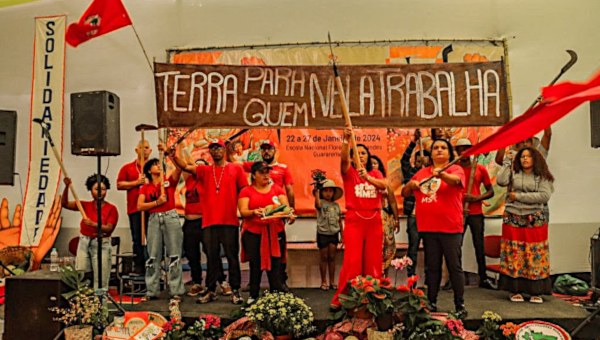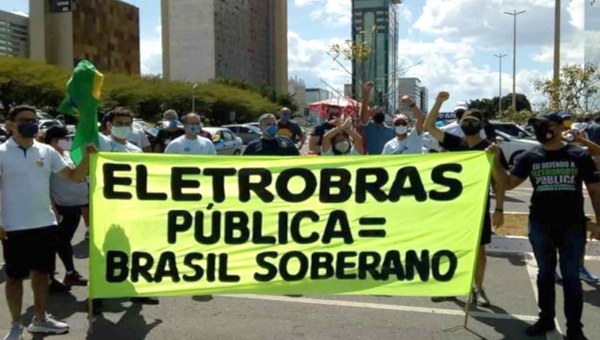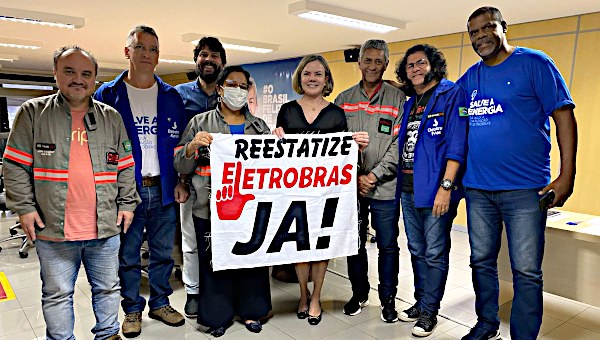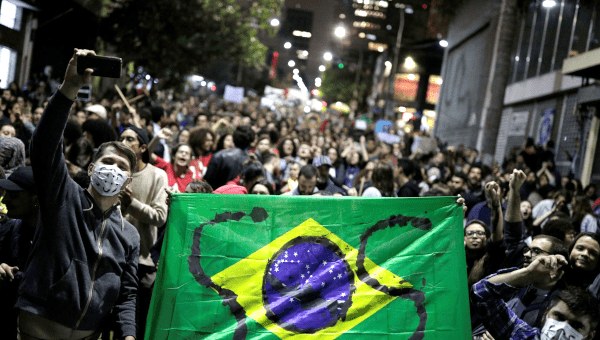Brazil: Fascism on the Verge of Power?
The extreme right-wing candidate Jair Bolsonaro won the Brazilian presidential elections on 28 October in the second round with a margin of 11 million votes (all in all about 58 million or 55 per cent) against the candidate of the Workers’ Party (PT) Fernando Haddad with 47 million votes, representing 45 per cent of the vote. Another 40 million Brazilians did not vote or cast empty ballots instead. What is to be expected from the incoming presidency that starts on January 1, 2019? And why did voters turn to the radical right after 13 years of governments led by presidents from the PT plus two years of an interim neoliberal government that came to power via a parliamentary coup?
The spectacular fact is not what is visible at first sight – that the PT candidate Haddad lost – but that the traditional right-wing parties, the Brazilian Democratic Movement (PMDB) and the Brazilian Social Democratic Party (PSDB), sank into meaninglessness. Their candidates, Meirelles of the PMDB, the traditional party of rural elites and the incumbent president Michel Temer, got 1.2 per cent in the first round of the elections, and Geraldo Alckmin of the PSDB, the party of urban elites and the middle-classes, got 4.8 per cent of the votes.
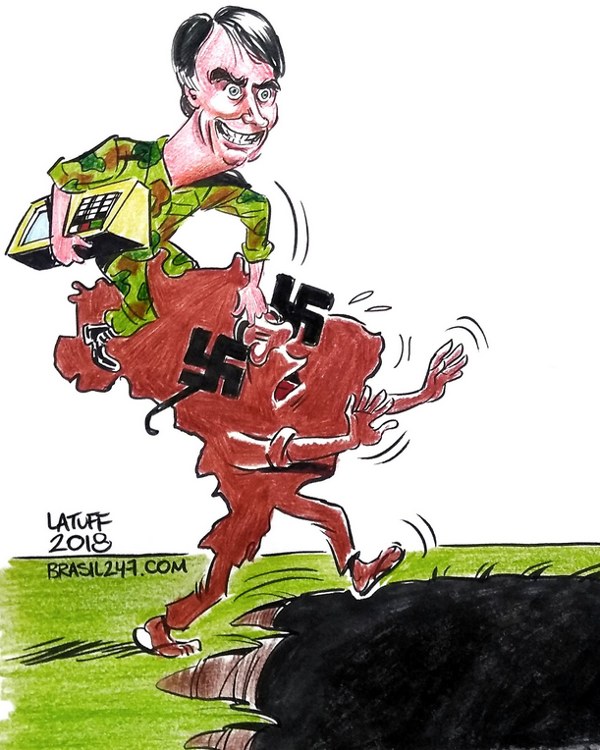
The PMDB and the PSDB have never been mass parties with a fixed ideology, but rather, elite formations that moulded their ideology from left to right and back again, and all the while exercising a staunch right-wing agenda in practice. Thus, Bolsonaro was able to replace the traditional right by being a member of a nano-sized party, the Partido Social Liberal (PSL), that he had joined only on January 5, 2018.
The PT defended its position as the main opposition party, and as the biggest party bloc in parliament, despite fierce anti-PT propaganda from Bolsonaro and from all other opposition parties. The strongholds of the PT are the regional states in the poor Northeast, where Haddad obtained victories in both rounds and where regional governors from left-wing parties were elected.
Corruption, Crime, Family Values
One basis for the success of Bolsonaro was the anti-corruption movement that had swept the country with massive demonstrations in 2015 and 2016 and which formed the popular basis for the impeachment of president Dilma Rousseff in 2016. The parliamentary wing of the anti-corruption movement, primarily the PMDB, was swallowed by its own success, since demonstrators developed a general anti-establishment sentiment, primarily directed against the PT, but also against the PMDB and the PSDB. A large number of politicians of all three parties went on trial or were convicted in the ongoing anti-corruption investigations, not the least of which was the powerful evangelical Eduardo Cunha from the PMDB who orchestrated the impeachment of Rousseff, and who is now in jail.
The issue dominating Bolsonaro’s campaign, apart from family values, corruption and unemployment, was unequivocally public security. Brazil saw 60,000 homicides in 2016. This is a rate of 27 homicides per 100,000 inhabitants. Only a few countries like Honduras and Venezuela have a higher homicide rate, while in violence-ridden Mexico it is 16 per 100,000, in the U.S. 5, in the UK 0.9 and in Germany 0.85. Apart from homicides there is a high number of robberies and burglaries in Brazil – in other words, Bolsonaro tapped into an area which comprises a serious issue for many citizens in Brazil.
Bolsonaro’s proposals in this regard are quite simple. Not only the possession (which is already legal) but also the carrying of firearms shall be legalised, and policemen that kill ‘gangsters’ shall not face any investigations. It is quite obvious that the latter proposal invites all kinds of misuse, including the killing of political opponents, business competitors and so on. The Brazilian police force is today already one of the most violent ones worldwide since 5,000 out of the 60,000 homicides in 2016 were committed by policemen in service. Thus, it is easy to understand that Bolsonaro’s proposals will not lead to a decrease in crime, and if anything, the opposite. Nonetheless, he was able to tap into the frustration about rising crime, which is a topic that earlier governments did not tackle enough, since homicide rates kept rising. This rise is highly unequal across regions. The states of Sao Paulo and Rio de Janeiro saw very high crime rates in the 1990s but now have a homicide rate of around 10 per 100,000 inhabitants, while in the North and the Northeast of the country, homicide rates increased significantly.
The reasons for the rise in crime were not debated during the election campaign by any of the candidates. Paradoxically, the rise in crime was one of the side effects of the social programs of PT. These brought much more income to the poor states in the North and the Northeast, which also meant that poor people could afford to buy illegal drugs for the first time.1 This led to an expansion of the two main crime syndicates, Comando Vermelho and Primeiro Comando do Capital, in Rio and Sao Paulo to the North, respectively. These two groups established a truce regarding the division of their territories in the Southeast of Brazil, but the expansion north led to fighting for market share in the poorer regions – among themselves and against the respective local mafia. The PT governments of Luiz Inácio Lula da Silva (Lula) and Dilma Rousseff had not shown much coherent initiative in engaging in public security – not really a classic area of action for social-democratic governments.
A third reason for Bolsonaro’s victory is a longer-term development. This involves the rise of evangelical churches, which command a growing wave of conservative social values that emanate from them. These are not churches in the traditional sense but commercial empires that even see bankruptcies and mergers, and acquisitions at times. They maintain political parties and influential TV channels. Similar to what emerged in the 1980s and the 1990s in the U.S., Bolsonaro consistently used the argument of a moral majority, accusing the left of ideological indoctrination, primarily through the public education system. During the electoral campaign, much of Bolsonaro’s ire was directed against topics like sexual education in schools and gender studies in general, and everything that has to do with feminism.
It was mainly these three ingredients – corruption, public security and conservative family values – that managed to form a seemingly coherent profile for voters. Taken together, Bolsonaro successfully created an image of the ‘Left’ consisting of intellectuals detached from the everyday life concerns of ordinary people, while he instead was speaking the ‘real’ language of the people, addressing their ‘real’ problems – a tactic all too well known from predecessors like Erdogan, Modi and Trump.
A striking phenomenon of the whole presidential campaign was that there was literally no public debate about policies; Bolsonaro had withdrawn himself from any public debates after the knife attack against him on September 6, 2018. Much of his campaign relied on fake news sent via whatsapp groups, which had an extraordinary effect. Any debates that happened occurred with obscure groups on social media and thus out of the traditional public realm. As an example, fake news claimed the PT’s incoming government planned that the state would decide the gender of children and that children would become the property of the state after reaching the age of five. Surveys found that 70 to 80 per cent of the receivers of this fake news believed the content.
Yet the background to this shift to the radical right reflects more than just the rise of the evangelical churches, whose members today encompass about 27 per cent of the Brazilian population. The power centres that support the rise of Bolsonaro include agribusiness, mining companies, the financial bourgeoisie and the Brazilian military. Apart from the military, they are composed both of national and international factions and are not exclusively located in the Brazilian power structure. While the Brazilian manufacturing industry’s support for Bolsonaro was not overwhelming due to his ideas on the liberalization of foreign trade, the bosses of German companies Mercedes-Benz and Volkswagen – Volkswagen was for a long time Brazilian’s largest private employer – expressed unrestricted enthusiasm.
A balance-Sheet of the Workers’ Party in Power
But apart from the elites, why did the population move electoral support away from the PT governments to this odd coalition of evangelicals, Chicago boys and military generals that will take power in 2019? For an explanation, we have to go back to the time of the governments led by presidents Lula and Dilma Rousseff of the PT.
There are two explanations as to why the PT lost popular support. The first involves Rousseff’s shift toward more state intervention and the subsequent withdrawal of the bourgeoisie’s support for her government after 2013; and second, the classic PT constituency of the working class became unhappy with the too many compromises that the PT presidents made with the ruling classes.
Although these two explanations seem to contradict each other, they both hit a point. Rousseff’s government came under fire from both sides simultaneously. She did not support the large strike movements in 2011 and 2012 demanding higher wages in construction and the public sector, which she saw as being at odds with her neo-developmentalist agenda; thus, she could not use the popular drive of those strikes as support for her own project.
The two terms of Lula’s presidency have been seen as a success, since extreme poverty was reduced significantly, the minimum wage rose above inflation, and a high number of formal jobs were created. But these initial successes hit a ceiling: 95 per cent of the newly created jobs were low waged, and workers started to expect more after 10 years of social democracy. Infrastructure in health, transport and education had improved but were still deficient, and the conditions of work did not see fundamental changes. The industrialization program that Lula had started and that was taken over by Rousseff created many jobs in construction, but with miserable working conditions despite most funding for it coming from public coffers.
Rousseff tried to deepen the nature of social-democratic state intervention by lowering notoriously high Brazilian interest rates and putting a cap on energy prices. The problem was that she did this in a technocratic vein, without securing political support for it and without a powerbase of her own. In this way, it was easy for the bourgeoisie to disrupt this strategy.
In short, the main strategy of Lula and Rousseff in power relied on widening income-redistribution via compromises with the ruling class and participation by the broad masses in individual consumption but not on the active mobilization of the popular masses. This came with important side effects that now turn out to compliment the story of the PT in power.
First, capital concentration continued to increase between 2002 and 2014, primarily in landed property, agribusiness, the food sector and in the garment, construction and steel industry. Acquisitions by Brazilian companies in other countries such as Argentina, Peru, Ecuador and Paraguay played a considerable role.
Second, public financial support for large agribusiness rose much faster than public support for smaller scale family agriculture. In 2003, when Lula came to power, support for agribusiness was five times higher than that for family agriculture. By 2015, one year before Rousseff left office, it rose to an amount that was six times higher. In addition, although agrarian reform proceeded during the presidencies of Fernando Henrique Cardoso in the 1990s and during Lula’s presidency until 2010, it stalled completely during the first mandate of Rousseff from 2011 on.
Third, the Brazilian economy became much more dependent on raw material exports during the presidencies of Lula and Rousseff, due to the expansion of trade relations with China. This is reflected in a steep fall in the amount of exports and value-added in manufacturing, and a corresponding rise in the agricultural and extractive industries. Primary commodity exports rose from 28 per cent of exports in the early 2000s to 50 per cent in 2015, and the contribution of industry to national GDP sank from 27.8 per cent in 1988 to 14.5 per cent in 2010. Once commodity prices went down, the Brazilian economy stuttered and shrunk in 2014 and 2015. A lack of R&D and high-tech industrial sectors led to a renewed dependence on raw material demand on the world market.
Fourth, evangelical churches were integrated into political alliances and granted huge tax relief during the 2000s. The Igreja Universal, as one example, which is now one of the most important supporters of Bolsonaro, had previously supported the PT-led governments.
Fifth, the Brazilian military saw an increase in funding during the 2000s and was granted the lead role in the United Nations Haiti Mission in 2004, where Brazilian commanders subsequently committed massacres among poor residents and social movement activists. The leader of the Brazilian mission in 2004 and 2005 was general Augusto Heleno, today one of the key figures in Bolsonaro’s team and a staunch defender of the military regime from 1964 to 1985. He is set to hold the important post of the Office of Institutional Security, which provides immediate advice to the president on military and security matters.
In short, the PT presidents nurtured many of their natural enemies, thinking they could co-opt and pacify them. This actually worked for a while but made them stronger in the long-term. One has to underline here also that both Lula and Rousseff disconnected to a certain extent from the PT itself during their presidencies, and that their presidencies were based on coalitions with the rural conservative PMDB and other old-style clientelist parties. Given that the PT never had more than 20 per cent of the seats in parliament, the room for manoeuvre was limited, and not all these were mistakes immediately attributable to the PT. In the “Mensalao” scandal in 2005-2006, it was revealed that important leading figures of the PT paid deputies of other parties in order to get legislation passed, which throws a light on its political weakness. But since their presidential candidates were in power from 2003 to 2016, the PT as a whole was made responsible for the aftermath.
Bolsonaro’s crude coalition is to some extent an expression of desperation from the side of the ruling class. The PT, with its moderate gains for the popular masses and social movements, is demonized in the eyes of the Brazilian bourgeoisie with its irrational hatred of the poor majority of the population. But the enormous problems of the Brazilian social formation will hardly be tackled by the new government, not even in the interests of the bourgeoisie. While Bolsonaro has delegated much responsibility for economic issues to the ultra-liberal Paulo Guedes, Bolsonaro himself oscillates between ultra-liberalism and statism, and it is impossible to say at this point what the economic program of the government will be. Once an ultra-liberal proposal has been sanctioned in public by Bolsonaro, he takes it back a week later.
This schema has repeated itself now various times in the past weeks. Guedes himself, who will head a super-ministry that includes the three earlier ministries of Finance, Industry and Planning, does not seem to have a well thought-out plan apart from liberalizing and privatizing everything. He is at the same time facing an investigation by the federal police due to the suspicion that one of his financial companies illegally appropriated millions from the pension funds of state companies. It would not at all be surprising if Guedes were dumped in the coming months. But who will replace him? The only figure in the government to be taken seriously could be Sergio Moro, the judge and former head of the anti-corruption investigation, who will be the minister of Justice and Security. The fact that he threw Lula, who was leading with a wide margin against Bolsonaro in opinion polls, into police custody in April 2018 (the case is not yet fully decided), and is now entering the government himself, leaves more of a bad taste in the mouth.
If one would hold the incoming government to account on the basis of its promises, voters should expect results at least in terms of a fall in crime and in unemployment. This will be hard enough to achieve on its own, given the complete lack of a proper plan and program with the incoming government. But the government will first of all have to deal with pension reform. 70 per cent of the Brazilian budget is spent on pensions for public sector workers and military personnel. The bigger portion of the deficit comes from military pensions, since soldiers usually start to receive their pension at the age of 50 and get 100 per cent of their former salary, while their daughters receive a pension also. From Guedes’ point of view, a number of privatizations are on the table: the refineries of Petrobras, the entire company Eletrobras and considerable parts of the public education system. But in this respect also, Bolsonaro keeps changing his mind.
Observers have identified three wings in the new government: the political wing around the evangelical Onyx Lorenzoni, the military wing and the economic wing, headed by Guedes. Obviously, there is considerable disunity among these three factions, and Bolsonaro’s low level of overall competence as an integrating figure means that a general consensus is missing. How the new government will fare will depend a lot on an agreement between these three wings on a coherent program and whether this program will meet with success in at least a few areas.
In order to kickstart growth and employment, a classic state investment program in R&D and public subsidies for industrial development would be necessary, which is completely at odds with Bolsonaro’s economic wing. Such a program would require that the military wing gains preeminence, which will not be to the liking of the financial bourgeoisie. Bolsonaro’s lack of a coherent economic program might be the biggest Achilles heel and can easily cost him popular support. It is obvious that voluntarism dominates, and the fact that the Brazilian bourgeoisie could not come up with a better option says a lot about its own rotten state.
In any case, a coup by the military, in the sense of immediately exercising power, is not on the agenda. If deemed necessary, the military will try to strengthen its influence within the government. Any form of immediate rule by the military would put at serious risk its own legitimacy as an institution in case the government fails to deliver, and hence, diminish its influence, which is still considerable. In this respect, some observers say that the strong presence of the military in the new government could be one of the few chances to get rid of its overarching influence, which was never diminished to an extent comparable with Argentina or Chile after the end of their respective dictatorships, since the military will be held accountable for the success or failure of that government.
External Interests
Already mentioned was the strong significance of external forces like mining companies, agricultural traders and the international financial bourgeoisie for Bolsonaro’s project. In general, the external orientation of Bolsonaro’s government aims for a tight link with the U.S., both politically and economically. Bolsonaro already made signs he will approve the sale of one of the few national champions of Brazil, the aerospace company Embraer, to Boeing. Even the neoliberal government of Temer showed strong hesitation in backing the sale.
In economic terms, this close relationship with the U.S. will only strengthen the subordination of the Brazilian bourgeoisie to other powers. Brazilian agribusiness does not have much room for manoeuvre in weakening its links to China, since it profits immensely from the trade spat between China and the U.S. and is in direct competition with U.S. agribusiness, especially in the area of soybeans. Three of the four large trading companies in Brazilian agribusiness are mainly U.S.-based (Cargill, Bunge, Archer Midlands), and they will support the maintenance of economic links with China.
One of the sectors in Brazil that currently sees significant investment is the oil sector. Various rounds of sales have taken place for the drilling rights for oil located in the so-called pre-salt geological layer that was discovered in 2006. This discovery will put Brazil on the map in terms of known oil reserves at least until 2050. In the last five bidding rounds in autumn 2018, it was mainly British, Norwegian and U.S. oil companies that received the major stakes, with smaller parts left for Chinese companies and Brazilian Petrobras.
In this vein, the realignment of the Brazilian government with U.S. interests is mainly about securing the vast natural resources in Brazil for the traditional imperialist bloc. Countless new mining projects for gold, iron and other minerals are currently planned in the Amazon, and the potential for Brazil to become a large petropower itself will be effectively prevented by the new government because it aims to subordinate national interests to U.S. imperialist interests with the sale of drilling rights to British companies BP and Shell, to U.S. companies ExxonMobil and Chevron and to the Norwegian Statoil.
Again, this can lead to some conflicts between the ultra-neoliberal and the military wings of the government, but it is not unlikely that the military , with its more statist aspirations, will have to bow down to the power of the national and international financial bourgeoisie. In this respect, we should not underestimate how Brazilian agribusiness, the powerhouse of the Brazilian economy, is today closely intermingled with the interests of the financial bourgeoisie, since it profits more from speculation with land than from the sale of agricultural commodities.
Contradictions of the New Wave of Right-Wing ‘Anti-Globalism’
Another international dynamic is the current wave of right-wing ‘anti-globalist’ governments, not the least of which is the U.S. government under Trump. We should not overestimate the stability of these governments. What we see up to now is that they do not have a stable political support base and are not able to rally the state apparatuses behind them in a coherent way. This is what distinguishes them from traditional fascism. They are also not capable of doing away with elections but have to limit themselves to manipulating them.
Since other than in the 1920s and 1930s, industrial employment is shrinking due to technological developments, these governments will also have much bigger problems in managing the economic contradictions they will face. For example, the ultra-right-wing foreign minister of the incoming Bolsonaro government, Ernesto Araújo, does not refrain in repeating that globalization is piloted by ‘cultural Marxism’. Given that the future economics minister, Paulo Guedes, got rich in international finance (as did other figures of ‘economic nationalism’ like Steve Bannon and Jacob Rees-Moog), these ideological bubbles of the extreme right-wing seem ridiculous. But especially in the area of family values, the attacks against gender studies and feminism have worked in a country like Brazil that has seen one of the highest incidences of violence against women and homosexuals for decades. Apart from offering a distraction from the blunt contradictions in the governmental agenda, the anti-feminist attacks will most likely lead to a spike in violence against women and other persons that do not conform to the ultra-conservative agenda. Violence in the rural areas where political assassinations have never stopped and have increased significantly in the past two years, will reach new record numbers. The rights of traditional communities, indigenous people, landless workers and maroons for their own land have been seen as an obstacle to more mining and agricultural projects by Bolsonaro. But the bigger change could occur in urban areas if political oppression is stepped up there too.
It is obvious that Bolsonaro still faces a high rate of rejection among the population, given the high number of voters for Haddad and the high number of non-voters. Social movement mobilizations will be stronger if the government makes mistakes, and large mobilizations can be expected in any case. In particular, the landless workers’ movement Movimento de Trabalhadores Sem Terra (MST), the urban-based homeless movement Movimento de Trabalhadores Sem Teto (MTST) and the more recent incarnations of the women’s movements have a high capacity for mobilization. The parliamentary opposition is pretty much split but might cooperate on crucial legal projects. Since the agribusiness caucus is firmly behind Bolsonaro, he might be able to get important projects through parliament. One can be sure that the high amount of repression against social and labour movements will increase further and that pro-gun propaganda will motivate both paramilitaries and the police to use arbitrary violence as they please.
Nevertheless, this is not yet a program for a hegemonic fascism, which needs a positive agenda to some extent. Ailton Krenak, one of the most well-known indigenous leaders in Brazil, was asked about his expectations of the new government in the second half of November. He responded, “Well, we have been surviving for 518 years. I am rather concerned about white people and how they will deal with this.” •
Endnotes
- For readers of Portuguese, this interview with José Maria Nóbrega from Federal University of Campina Grande, provides more insight into this issue: Alessandra Duarte: Nordeste nao está preparado para aumento da criminalidade, December 14, 2011.


